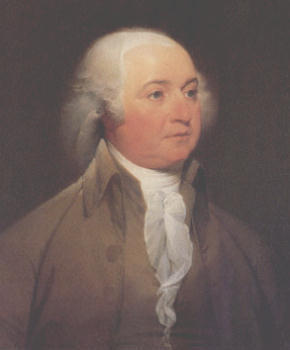John Trumbull
- Born: 6 Jun 1756, Hartford CT
- Died: 1843
General notes:
Artist
Events in his life were:
- General. John Trumbull was born in Lebanon, Connecticut on June 6, 1756. His father, Jonathan Trumbull, was a successful Connecticut merchant, patriot, and Colonial Royal Governor. His mother, Faith Robinson, was a direct descendant of John and Priscilla Alden, and the Pilgrim leader John Robinson. When John Trumbull's father was a young man, he had originally gone to Harvard to study the ministry, and he encouraged his son to do the same, or to study law. To his father, art was not of the same caliber as the ministry or law, but John knew that he was an artist. When he was 15, he followed his father's wishes by enrolling at Harvard, but once he was there, he focused on painting and drawing. He graduated from Harvard in 1773, taught school for a short time, and kept working on his pursuit of his art.
The American Revolution propelled John Trumbull into the military arena. As Adjutant of the 1st Connecticut Regiment, he marched to Boston, and observed the Battle of Bunker Hill. As a witness to the people and places surrounding the nation's founding, Trumbull kept his artist's eye peeled. His sketches attracted the attention of General George Washington, and he served for a time as Washington's aide-de-camp. After the war, Trumbull settled in Boston to work on his art, and then in 1779 he left for Europe. Armed with a letter of introduction from Benjamin Franklin, Trumbull sought out Benjamin West, an artist who was commissioned by King George III to paint historical works. Trumbull studied under West, and through this relationship, John Trumbull determined that his mission as an artist would be to depict on canvas the American Revolution and the people who represented the birth of the new nation.
John Trumbull's works include portraits, engravings, and historical paintings. Thomas Jefferson and John Adams viewed his "Battle of Bunker Hill", and "The Death of General Montgomery at Quebec", and urged him to continue his historical depictions, suggesting some of the themes for his future works. John Trumbull set out to capture the most important historical moments of the American Revolution. Among his other works, he is best known for "The Declaration of Independence", "The Battle of Trenton", "The Surrender of General Burgoyne", "The Battle of Princeton", "The Surrender of Lord Cornwallis", and "Washington Resigning His Commission". Some of his paintings, like "The Declaration of Independence", took Trumbull years and years to complete as he traveled to capture accurate portraits of the notables that populated his scenes. Trumbull often painted miniatures, and then would repaint his works in larger formats. In 1817 the U.S. Congress commissioned Trumbull to paint four of his works in the Capitol's Rotunda. These were large repaintings of his best-known "The Declaration of Independence", as well as "Washington Resigning His Commission", "The Surrender of General Burgoyne", and "The Surrender of Lord Cornwallis". Trumbull left much of his art entrusted to Yale University. When John Trumbull died in 1843, he had succeeded in his quest to become the painter of the American Revolution.

- Example: Portrait of John Adams, in 1797.
|